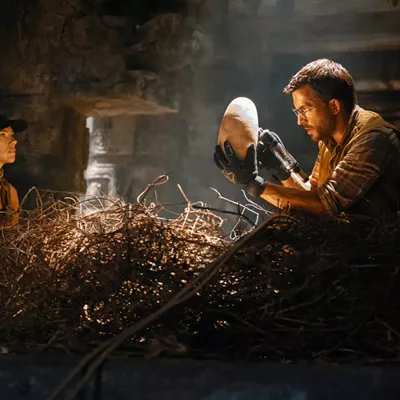For a movie that spends nearly three hours plumbing the depths of its main character's psyche, Andrew Dominik's Blonde offers a remarkably superficial take on what drove Marilyn Monroe (Ana de Armas). Based on Joyce Carol Oates' 2000 novel, a fictionalized account of the life of the legendary actress, Blonde reduces everything in Monroe's life, from triumph to tragedy — although it's mostly tragedy — to daddy issues.
Born Norma Jeane Mortensen, she's initially raised by her mentally ill mother, Gladys (Julianne Nicholson), who shows young Norma Jeane a photo of a handsome man Gladys claims is Norma Jeane's father. Both Norma Jeane and the film then fixate on that mythical man, constantly returning to his image and Norma Jeane's search for him over the course of the lengthy running time. If Dominik is aiming to bolster Monroe's troubled reputation and legacy, all he's done is turn her into a passive victim with little agency or understanding of her own motivations.
As a film, Blonde is a chaotic, impressionistic odyssey through Monroe's life, with only cursory nods toward providing context and historical details. Characters come and go without the movie defining their relationships to Norma Jeane or even, often, their names, and only viewers with existing knowledge of Monroe's life will be able to identify the significance of some of the people onscreen. Biopics don't have to play out like Wikipedia entries — and are generally better when they don't — but Blonde circles around the same basic themes again and again without insight or emotional engagement. Poor Norma Jeane is horrifically mistreated by nearly everyone in her life, and it makes almost no impact.
Instead, Dominik offers showy visuals that distance the viewer from Norma Jeane rather than bringing her closer. The movie is constantly switching aspect ratios and between color and black and white, frequently within the same scene. Those visual transitions lose their ability to signify anything important when they're used so regularly, relegated instead to slightly annoying background details. The editing blurs the lines between what's actually happening to Norma Jeane and what she's envisioning in her increasingly drug-addled mind, and that allows for some striking juxtapositions, although Dominik's shot composition often seems designed for shock value. The vaginal point-of-view shots during multiple abortion procedures are mostly just grotesque, cheapening the trauma that the movie is attempting to convey.
Through it all, de Armas makes a valiant effort to hold onto Norma Jeane as a person, although her default expression remains dazed and uncertain. In one scene, as her film career is taking off, Norma Jeane makes an assertive play for compensation equal to co-star Jane Russell's on 1953's Gentlemen Prefer Blondes, and that single moment affords the character more energy and independence than the entire rest of the movie. With all of her romantic interests, including her husbands Joe DiMaggio (Bobby Cannavale) and Arthur Miller (Adrien Brody), Norma Jeane merely floats along, subject to their whims and abuses. Dominik's graphic depiction of Norma Jeane's liaison with President John F. Kennedy (Caspar Phillipson) is crude and ugly, only adding to the humiliation she experiences.
While men boss her around, Norma Jeane longs for a child, which Dominik depicts via laughable scenes of CGI fetuses (including one that talks to her in voiceover) during Norma Jeane's ill-fated pregnancies. It's another misguided bit of stylization that hammers home simplistic themes at the cost of character development and narrative coherence. Blonde doesn't need to be a dry history lesson, but it should have something more interesting and valuable to say underneath its distracting barrage of questionable imagery. ♦






















